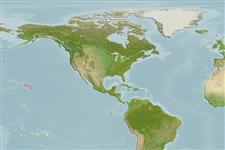>
Clupeiformes (Herrings) >
Dorosomatidae (Gizzard shads and sardinellas)
Etymology: Sardinella: Latin and Greek, sarda = sardine; name related to the island of Sardinia; diminutive (Ref. 45335).
Environment: milieu / climate zone / depth range / distribution range
Ecología
marino; rango de profundidad 0 - 50 m (Ref. 188). Tropical; 24°N - 19°S, 164°W - 141°W (Ref. 188)
Eastern Pacific: endemic to the Marquesas Islands. Introduced into Hawaiian waters.
Tamaño / Peso / Age
Maturity: Lm ? range ? - ? cm
Max length : 16.0 cm SL macho / no sexado; (Ref. 54980); common length : 10.0 cm SL macho / no sexado; (Ref. 188)
Espinas dorsales (total) : 0; Radios blandos dorsales (total) : 13 - 21; Espinas anales: 0; Radios blandos anales: 12 - 23. Body slender; total scutes 28 to 30; lower gill rakers strongly increasing with size of fish, about 45 at 5 or 6 cm standard length, 50 to 80 (maximum) at 6 to 10 cm. Vertical striae on scales not meeting at center, no perforations on hind part of scale. No dark spot at dorsal fin origin, no dark tips to caudal fin. Can be separated from other species by a combination of above characters.
Pelagic (Ref. 58302). Forms schools in coastal waters. Dominant species in beach seine hauls. Used as tuna bait (Ref. 6822). First reported case of clupeoid poisoning was in 1978 in the Hawaiian Is., probably caused by a planktonic dinoflagellate (Ref. 45133).
Life cycle and mating behavior
Madurez | Reproducción | Puesta | Huevos | Fecundidad | Larva
Whitehead, P.J.P., 1985. FAO Species Catalogue. Vol. 7. Clupeoid fishes of the world (suborder Clupeoidei). An annotated and illustrated catalogue of the herrings, sardines, pilchards, sprats, shads, anchovies and wolf-herrings. FAO Fish. Synop. 125(7/1):1-303. Rome: FAO. (Ref. 188)
IUCN Red List Status (Ref. 130435: Version 2024-2)
Human uses
Pesquerías: pesquerías de subsistencia; carnada: usually
Herramientas
Special reports
Download XML
Fuentes de Internet
Estimates based on models
Preferred temperature (Ref.
123201): 25.1 - 28.8, mean 27.5 °C (based on 63 cells).
Phylogenetic diversity index (Ref.
82804): PD
50 = 0.5000 [Uniqueness, from 0.5 = low to 2.0 = high].
Bayesian length-weight: a=0.00851 (0.00399 - 0.01817), b=3.05 (2.88 - 3.22), in cm total length, based on LWR estimates for this Genus-body shape (Ref.
93245).
Nivel trófico (Ref.
69278): 2.9 ±0.3 se; based on size and trophs of closest relatives
Resiliencia (Ref.
120179): Alto, población duplicada en un tiempo mínimo inferior a 15 meses (Preliminary K or Fecundity.).
Fishing Vulnerability (Ref.
59153): Low vulnerability (10 of 100).
